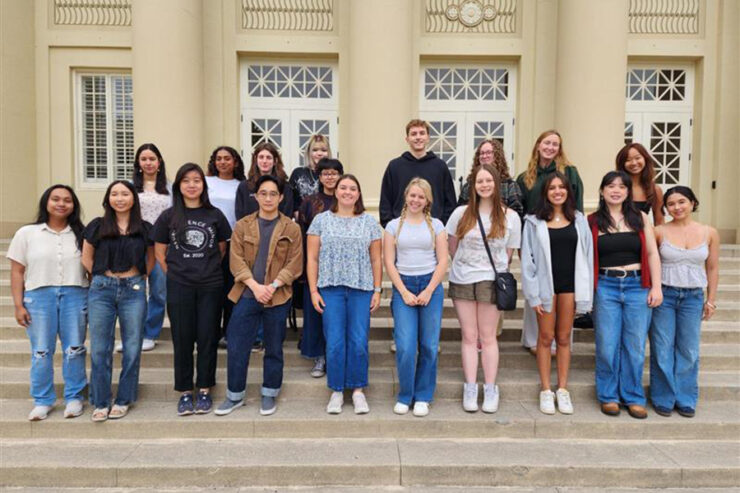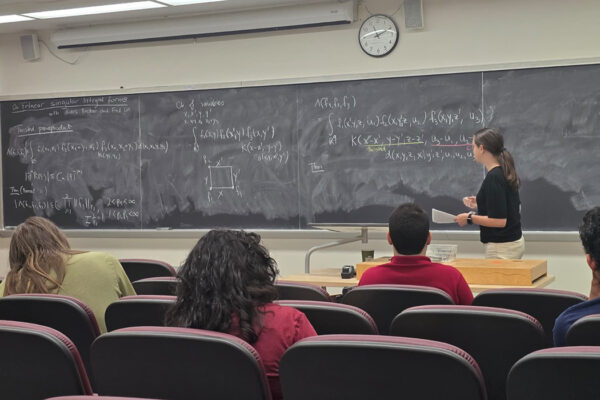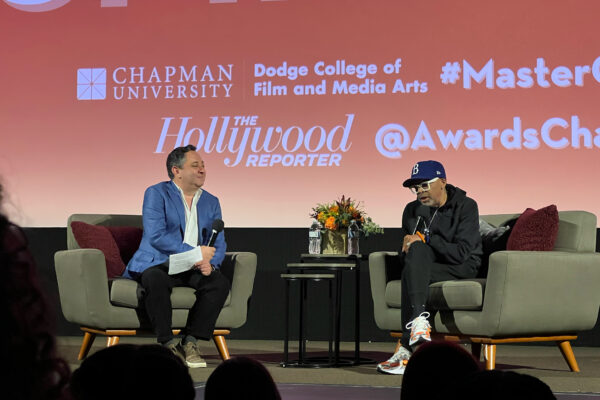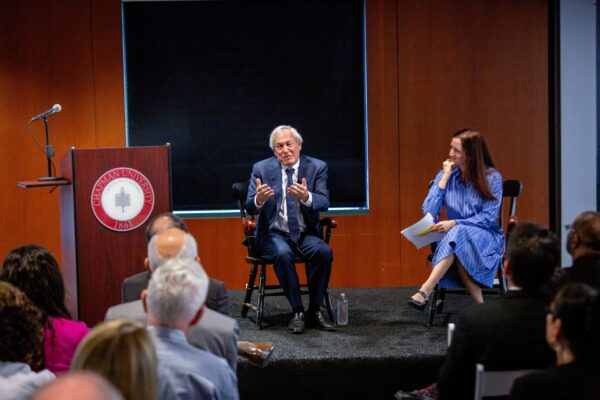This summer, undergraduate students at Chapman University are exploring potential cures for neurodegenerative disorders, developing diagnostic technologies for Alzheimer’s disease, studying the role of culture in body dissatisfaction issues, and investigating how historical plays can help modern audiences deal constructively with world conflicts.
These are just a few of the projects taking place as part of the 2025 Summer Undergraduate Research Fellowship (SURF) program.
“The purpose of SURF is not only to provide a platform for students to investigate their topics of interest, but it also allows us to foster a vibrant intellectual culture at Chapman that is focused on personalized mentorship, practical professional development and integration into interdisciplinary collaboration,” says John F. Hunter, assistant professor of psychology and director of the Center for Undergraduate Excellence (CUE), which organizes SURF.
During the on-campus, eight-week summer program, participants from any discipline can design their own research projects mentored by expert faculty in order to gain experience in hands-on research and creative scholarship. The fellowship includes a $4,000 stipend for 30 hours of research work per week.
“CUE invests in SURF students not merely as a reward for their past accomplishments, but rather as an investment in their future potential. We recognize great potential in these students and strategically position them to pursue excellence in their chosen domain. Our hope is that SURF provides these students a foundation that will serve as a steppingstone to even more profound impacts,” says Hunter.
This year, the roster of SURF participants is drawn from across Chapman’s schools and colleges, including students in science, engineering, humanities, social science and performing arts. Here are a few of the projects currently underway. See the full list on the Center for Undergraduate Excellence website.
 Annika Brown ’26
Annika Brown ’26
Computer Science, Theatre
“Developing an Intuitive Gesture-Based Interface and AI for Precise Object Positioning in Extended Reality”
Annika Brown, a rising senior, is creating an AI system that takes a messy virtual room and automatically generates an organized version, based on interior design guidelines.
“Users will also be able to use hand gestures to move the furniture,” says Brown,who plans to go into a software or game development-related field. “The system will take this information into account when creating the final layout.”
This project is giving her more hands-on experience with Unity, which is commonly used in the game industry. She’s also getting more experience with programming and artificial intelligence, which can directly translate into many of the types of jobs that she would like to pursue in the future.
 Hila Livneh ’27
Hila Livneh ’27
Data Science
“Enhanced Multimodal Fusion for Alzheimer’s Diagnosis Using Contrastive Learning”
“I’m developing a multimodal machine learning framework that fuses three different Alzheimer’s data types into a single representation to help classify diagnoses,” says junior Hila Livneh. “The goal is that by using contrastive learning with multi-modal fusion, this model will identify cognitive impairment more accurately than any one data source alone or by simply fusing the modalities together.”
Livneh has always been interested in the intersection between healthcare and technology. “This project is exactly what I needed to start diving more into the field. It gave me the opportunity to use machine learning for real‐world applications,” she says.
“I definitely felt my technical skills progress way beyond what classes alone could offer. Altogether, SURF grew my passion to pursue this as a potential career and gave me the practical experience and network that I’ll need for the future.”

Ashley Waller ’26
Psychology
“Flow in Motion: Detecting EEG Correlates of Flow State in Joint Improvisational Dance”
Ashley Waller ’26 merged her passions for neuroscience, psychology and dance with a study of the state of flow—meditative, focused, and effortless action—using electroencephalography (EEG) to bring it into a more objective realm.
“I was inspired to use dance as a medium for this given my own joint experience with dance and flow state as a dance minor at Chapman,” states Waller, who says this experience will better prepare her for grad school. “I hope that this research will help dancers and other physical athletes better understand their own flow and improve their performance.”
She adds that she appreciates the opportunity to be at Chapman for the summer. “Being able to continue to develop my academic skills as well as get to know more of my peers has allowed me to feel more connected to Chapman.”
 Louie Vitan ’26
Louie Vitan ’26
Psychology
“Exploring Student Engagement in Undergraduate Research at Chapman: An Analysis of Demographics and Barriers”
“My research project aims to examine potential barriers to participating in undergraduate research at Chapman,” says psychology major Louie Vitan ’26.
His study consists of two main components. First, an online survey that assesses undergrads’ levels of engagement in research, as well as perceptions of Chapman’s resources and campus climate in relation to the accessibility of research opportunities. Second, demographic analyses using basic census data of Chapman students who have participated in research, spanning as far back as 2012.
“I intend to pursue a Ph.D. in psychology, specifically focusing on culture and promoting educational equity within postsecondary institutions,” he says.
“This project is the first time I’ve been able to lead independent research addressing issues I’m passionate about. Having this opportunity to lead this kind of initiative will only strengthen my qualifications as an applicant and expand my breadth of knowledge.”
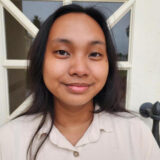 Franches Mikaela Faguingas ’26
Franches Mikaela Faguingas ’26
Health Sciences
“Retrocausality in Science Fiction and Physics”
In films such as “Back to the Future,” “Interstellar,” or “Arrival,” events in the past are influenced by what happens in the future. This phenomenon is known as retrocausality, the idea that it is possible for the future to have an influence on the past, or for the relationship between cause and effect to be inverted over the course of time.
“My project investigates the concept of retrocausality and the different types of retrocausality from the perspectives of modern physics and science fiction,” says Franches Mickaela Faguingas ’26. She plans to research the concept of retrocausality and apply conceptual distinctions from the philosophy of retrocausality to science fiction movies dealing with retrocausality, quantum physics, and time traveling.
“By enhancing my capacity to operate at the intersection of science and the humanities, this project advances my professional objectives,” says Fanguinas. “It enables me to improve my knowledge of philosophy and quantum physics while developing my multidisciplinary research and science communication abilities. These experiences will help me to become prepared for graduate school.”
Tamim Hatim ’27
Applied Human Physiology
“Investigating the Role of Stress Response Gene p58IPK in Drosophila Huntington’s Disease Models”
“I am studying a specific gene called p58IPK in fruit flies to understand its role in Huntington’s disease, a genetic neurodegenerative disorder that damages neurons over time,” says Tamim Hatim.
When cells are under stress—in this case, due to neurodegenerative diseases—a pathway called the Integrated Stress Response (ISR) becomes dysregulated and chronically activated, causing neuronal death if stress is not resolved. Haim’s research investigates whether modulating p58IPK levels can help reduce the severity of Huntington’s disease symptoms in flies.
“This project directly supports my career goals in research and healthcare,” says Tamim. “It provides me with essential experience in experimental design, troubleshooting, data analysis, and scientific communication, all of which are necessary skills in research and patient care. Participating in SURF allows me to be more independent in research and learn new techniques.”
Sohni Singh ’27
Psychology
“The Pressure to be Fair and Lovely: Exploring Body Dissatisfaction in Indian American Women”
Sohni Singh ’27 is conducting a survey-based research study on how growing up in an Indian immigrant household in the U.S. can influence women’s body image.
“I’m looking at factors like cultural beauty ideals, social comparison and media pressure to understand how these contribute to body dissatisfaction,” she says.
“This project has been an incredible opportunity to deepen my skills in psychological research, data analysis, and academic writing, all of which are essential for my goal of pursuing a doctorate in clinical psychology,” she says. The research is also personally meaningful, since it’s a topic Singh deeply cares about and one that’s often overlooked in mainstream research.
 Karli Jean Lonnquist ’26
Karli Jean Lonnquist ’26
Theatre, Peace Studies
“A New Exit: The Impact of Historical Play Adaptations on Modern Audiences”
Karli Jean Lonnquist ’26 is researching the dramaturgical process of theatrical adaptation and practicing adaptation by adapting Jean-Paul Sartre’s 1944 play “No Exit” for a contemporary American audience.
“By employing a Practice as Research methodology through peer interviews and group new-play workshops, I am writing the first draft of the adapted script and hosting a reading of the first draft of my adaptation to solicit audience feedback about the impact of the script-in-progress,” says Lonnquist.
“Ultimately, my project explores how historical plays can help modern audiences respond constructively to current conflicts,” she says.
As a current double major in theatre and peace studies, Lonnquist believes that storytelling can be healing and transformative for both individuals and communities. “With the freedom to explore how I can use my talents to cultivate theatre that directly addresses conflicts, this project will support my future multidisciplinary career in new play development, playwriting, and theatrical production for conflict resolution,” she says.
